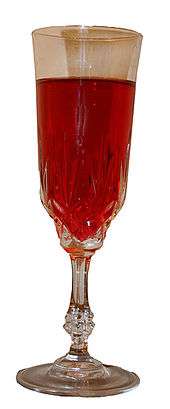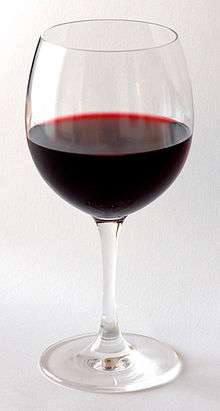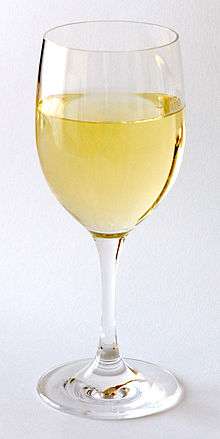Wine glass

A wine glass is a type of glass stemware that is used to drink and taste wine. It is generally composed of three parts: the bowl, stem, and foot. Selection of a particular wine glass for a wine style is important, as the glass shape can influence its perception.
Use
The appropriate way to hold a wine glass, especially when drinking chilled wine, is to grasp it by the stem, in order to prevent the temperature of the wine being affected by body heat.
Materials
High quality wine glasses once were made of lead crystal, which has a higher index of refraction and is heavier than ordinary glass, but health concerns regarding the ingestion of lead resulted in their being replaced by lead-free crystal. Wine glasses, with the exception of the hock glass, are generally not coloured or frosted as doing so would diminish appreciation of the wine's colour.
Shapes
The effect of glass shape on the taste of wine has not been demonstrated by any scientific study and remains controversial. It is however believed by some that the shape of the glass is important, as it concentrates the flavour and aroma (or bouquet) to emphasize the varietal's characteristic. One common belief is that the shape of the glass directs the wine itself into the best area of the mouth from the varietal.[1] This is based on false ideas about the nature of taste buds on the tongue, such as the thoroughly discredited tongue map.
Generally, the opening of the glass is not wider than the widest part of the bowl.
Most wine glasses have stems, although "stemless" wine glasses are now available in a variety of sizes and shapes as well.[2] These glasses are typically used more casually than their traditional counterparts, as they negate the benefits of using stemmed wine glasses.
Most common wine glasses can be divided into three types: red wine glasses, white wine glasses and champagne flutes. Wine tumblers (without stems) are also increasing in popularity.
Red wine glasses

Glasses for red wine are characterized by their rounder, wider bowl, which increases the rate of oxidation. As oxygen from the air chemically interacts with the wine, flavor and aroma are believed to be subtly altered. This process of oxidation is generally considered more compatible with red wines, whose complex flavours are said to be smoothed out after being exposed to air. Red wine glasses can have particular styles of their own, such as
- Bordeaux glass: tall with a broad bowl, and is designed for full bodied red wines like Cabernet Sauvignon and Syrah as it directs wine to the back of the mouth.
- Burgundy glass: broader than the Bordeaux glass, it has a bigger bowl to accumulate aromas of more delicate red wines such as Pinot noir. This style of glass directs wine to the tip of the tongue.
White wine glasses

White wine glasses vary enormously in size and shape, from the delicately tapered Champagne flute, to the wide and shallow glasses used to drink Chardonnay. Different shaped glasses are used to accentuate the unique characteristics of different styles of wine. Wide mouthed glasses function similarly to red wine glasses discussed above, promoting rapid oxidation which alters the flavor of the wine. White wines which are best served slightly oxidized are generally full flavored wines, such as oaked chardonnay. For lighter, fresher styles of white wine, oxidation is less desirable as it is seen to mask the delicate nuances of the wine. To preserve a crisp, clean flavor, many white wine glasses will have a smaller mouth, which reduces surface area and in turn, the rate of oxidization. In the case of sparkling wine, such as Champagne or Asti, an even smaller mouth is used to keep the wine sparkling longer in the glass.
Champagne flutes
Champagne flutes are characterised by a long stem with a tall, narrow bowl on top. The shape is designed to keep sparkling wine desirable during its consumption. Just as with wine glasses, the flute is designed to be held by the stem to help prevent the heat from the hand from warming the liquid inside. The bowl itself is designed in a manner to help retain the signature carbonation in the beverage. This is achieved by reducing the surface area at the opening of the bowl. Additionally the flute design adds to the aesthetic appeal of champagne, allowing the bubbles to travel further due to the narrow design, giving a more pleasant visual appeal.
Sherry glass

A sherry glass is drinkware generally used for serving aromatic alcoholic beverages, such as sherry, port, aperitifs, and liqueurs, and layered shooters. The copita, with its aroma-enhancing narrow taper, is a type of sherry glass.
Boccalino

A Boccalino is a mug used in Ticino, Switzerland, to drink local wine (Merlot or similar). It has a volume of approximately 200 ml.
Decoration
In the 18th Century, glass makers would draw spiral patterns in the stem as they made the glass. If they used air bubbles it was called an airtwist; if they used threads, either white or coloured, it would be called opaque twist.[3]
ISO wine tasting glass
The International Organization for Standardization has a specification (ISO 3591:1977) for a wine-tasting glass. It consists of a cup (an "elongated egg") supported on a stem resting on a base. The opening is narrower than the convex part so as to concentrate the bouquet. The capacity is approximately 215mL, but it is intended to take a 50mL pour.[4] Some glasses of a similar shape, but with different capacities, may be loosely referred to as ISO glasses, but they form no part of the ISO specification.
Measures in licensed premises
In the UK there has been a steady trend away from serving wine in the standard size of 125ml, towards the larger size of 250ml, even though, since 1 October 2010, alcohol retailers have been obliged by law to offer customers the choice of a smaller measure. A code of practice, introduced in April 2010 as an extension to the Licensing Act 2003, contains five mandatory conditions for the sale of alcohol, including an obligation for the licensee to make the customer aware that small measures are available.[5]
Capacity measure
As a supplemental unit of apothecary measure, the wineglass (also known as wineglassful, pl. wineglassesful, or cyathus vinarius in pharmaceutical Latin) was defined as 1⁄8 of a pint, or 2 fluid ounces (2 1⁄2 fluid ounces in the imperial system).[6][7] An older version (before c. 1800) was 1 1⁄2 fluid ounces.[8] These units bear little relation to the capacity of most contemporary wineglasses, or to the ancient Roman cyathus.
See also
References
- ↑ "Shattered Myths". Gourmet. August 2004.
- ↑ "Stemless Wine Glasses". Google search.
- ↑ Clarke, Michael. (2001). The Concise Oxford Dictionary of Art Terms. Oxford University Press.
- ↑ "ISO 3591:1977". ISO.org. Retrieved 2012-02-09. (payment required)
- ↑ Victoria Moore (4 January 2014). "Fight for your right to a smaller glass of wine". Wine. The Daily Telegraph. Retrieved 8 February 2016.
- ↑ Edward Quin Thornton (1901). Dose-book and Manual of Prescription-writing. W.B. Saunders. p. 20. Retrieved 21 December 2011.
- ↑ Weeks-Shaw, Clara S. (1808). A text-book of nursing: for the use of training schools, families, and private students. D. Appleton. p. 108. Retrieved 21 December 2011.
- ↑ James, Robert (1747). Pharmacopoeia universalis: or, A new universal English dispensatory. Containing. An account of all the natural and artificial implements and instruments of pharmacy, together with the processes and operations, whereby changes are induced in natural bodies for medicinal purposes .. With a copious index to the whole. Printed for J. Hodges and J. Wood. p. 623. Retrieved 21 December 2011.